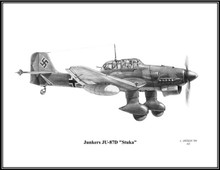 Loading... Please wait...
Loading... Please wait...- Home
- Combat Aircraft/Pencil Drawings ~ Free Shipping
- Junkers JU-87D "Stuka" ~ Free Shipping
Product Description
Print Size 8½" x 11" ----- Unlimited print edition
Junkers Ju 87D Stuka dive-bombers on a mission over the Russian countryside. The Ju 87G variant was used to devastating effect as a "tankbuster" with twin 37 mm cannons fitted under the wings.Despite having its vulnerability to enemy fighters exposed during the Battle of Britain, the Luftwaffe had no choice but to continue the Stuka's development as there was no replacement aircraft in sight. The result was the D-series. The Ju 87 D-series received better streamlined oil and water coolers, and an aerodynamically refined cockpit with better visibility and space. In addition, armor protection was increased and a new dual-barrel 7.92 mm MG 81Z machine gun with an extremely high rate of fire was installed in the rear defensive position. The engine power was increased again, the Jumo 211 J-1 now delivering 1,420 PS (1,401 hp, 1,044 kW). Production of the D-1 variant started in 1941 with 476 deliveries, rising to 917 D-1 and D-3 in 1942. The D-series saw extensive use in the Eastern Front and the Middle East. Bomb carrying ability was massively increased from 500 kg in the B-version to 1,800 kg in the D-version (max load for short ranges, overload condition), a typical bomb load ranged from 500 to 1,200 kg. The D-2 was a variant used as a glider tug by converting older D-series airframes. The D-3 was an improved D-1 with more armor for its ground-attack role. The D-4 designation applied to a prototype torpedo-bomber version. The Ju 87 D-5 was another ground-attack variant that appeared in mid 1943, it had the outer wing panels extended, dive brakes were removed and the wing-mounted 7.92 mm MG 17 machine guns were replaced by 20 mm MG 151 cannons. The D-6 was not built, for unknown reasons. The D-7 was another ground attack aircraft based on D-1 airframes upgraded to D-5 standard (armor, wing cannons, extended wing panels), while the D-8 was similar to the D-7 but based on D-3 airframes. It's a common myth that the D-7 and D-8 were specifically designed and built for night fighting as they were solely based on converted airframes and used for multiple mission types. Another variant derived from the Ju 87D airframe was called the Ju 87H, and saw service as a trainer.
Warranty Information
null








